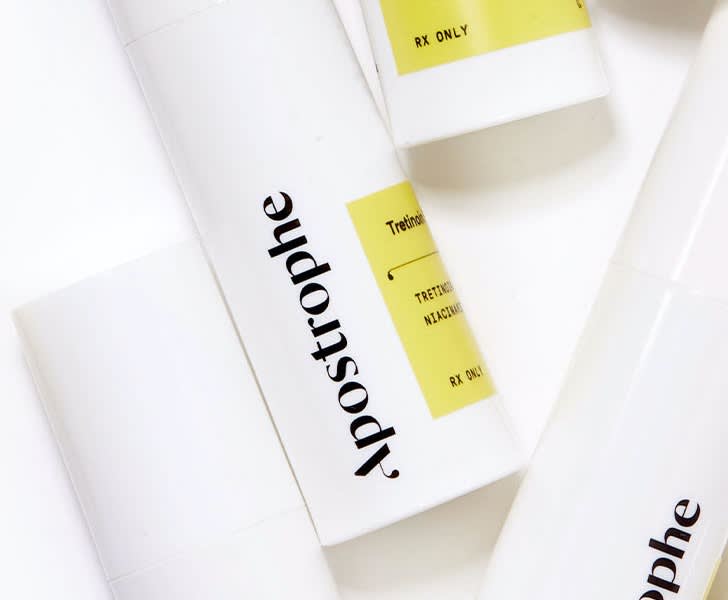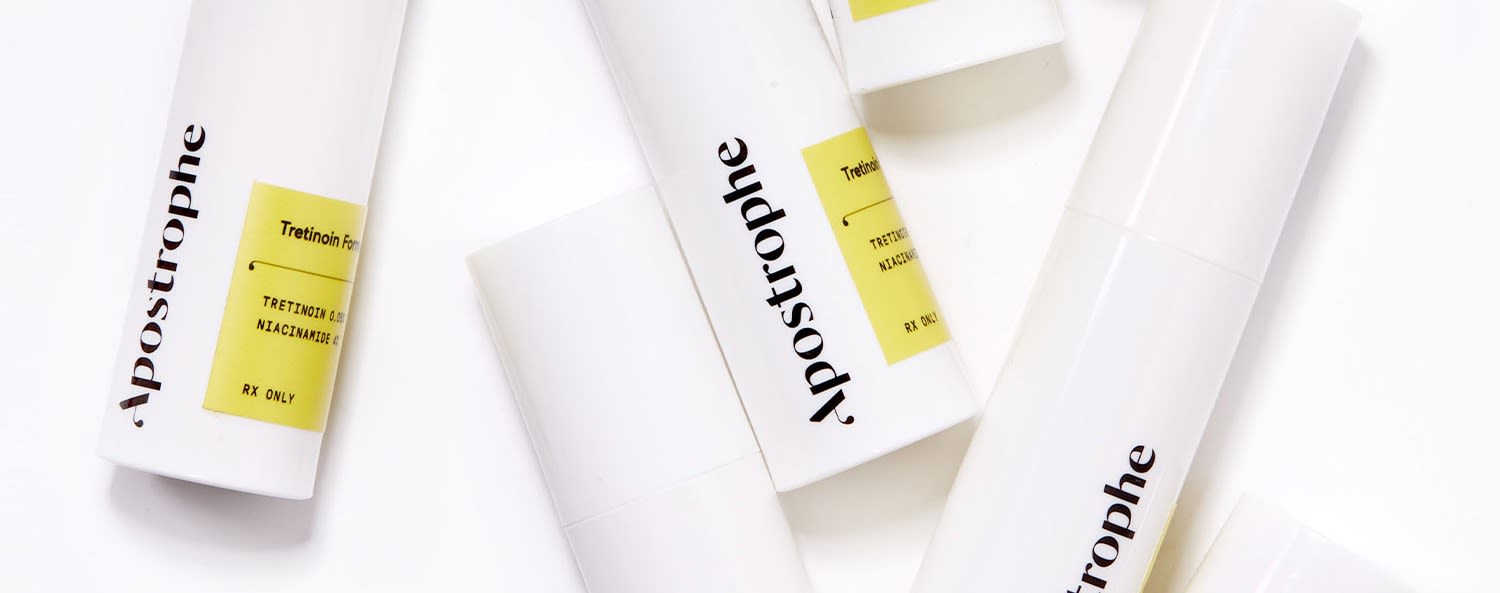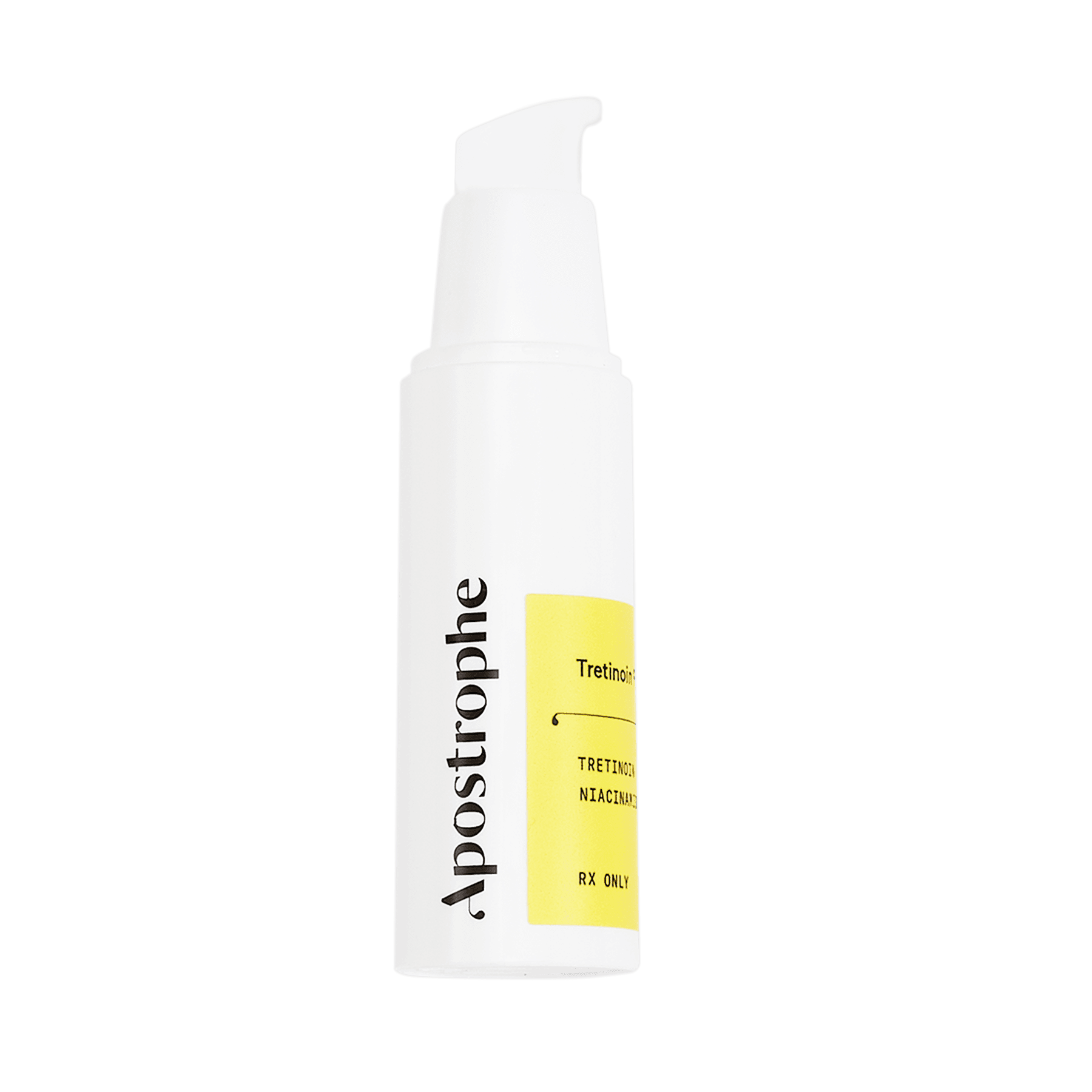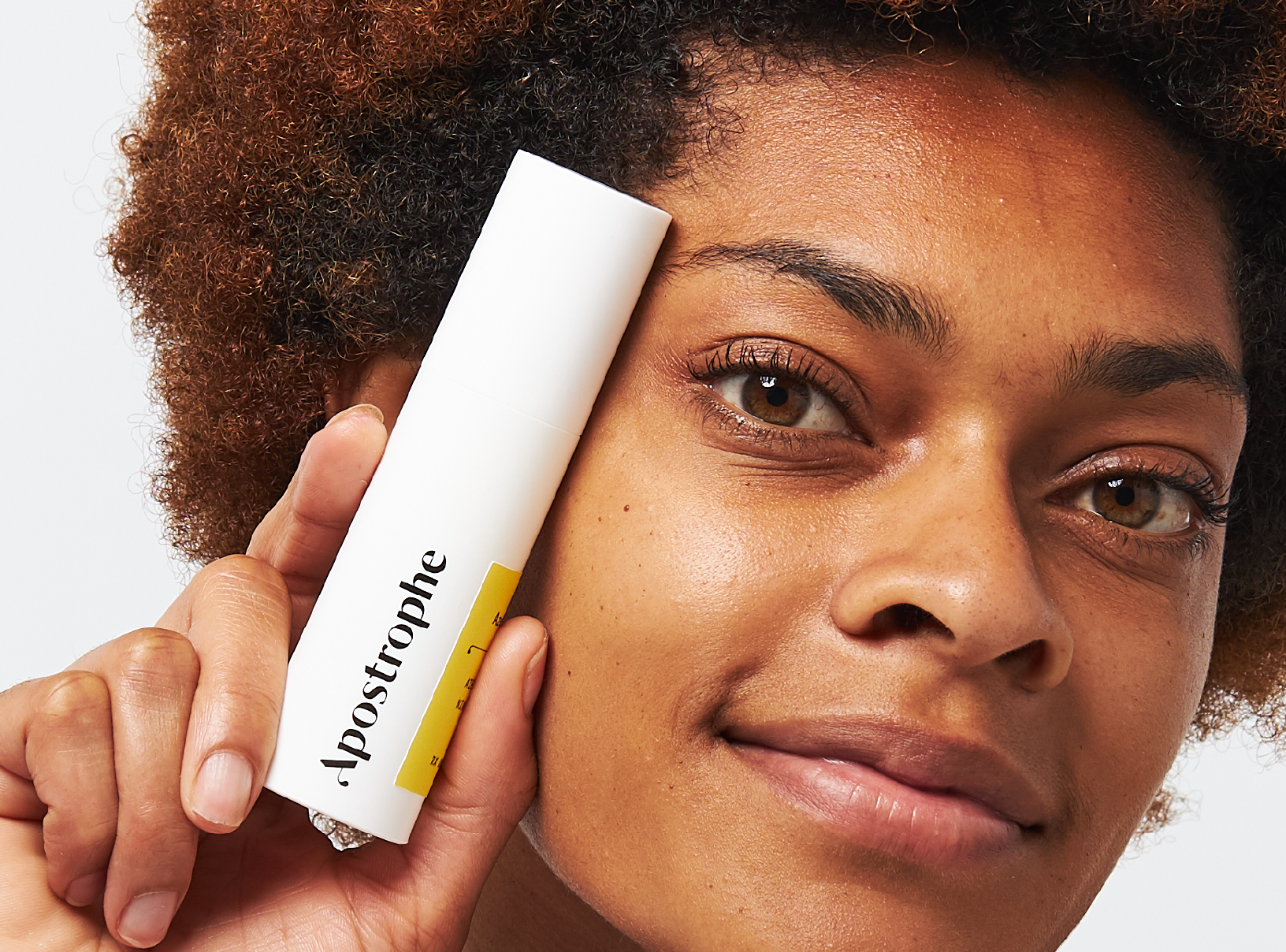Education
Tretinoin vs. Retin-A: is there a difference?


SHARE
Education
Tretinoin vs. Retin-A: is there a difference?
Medically reviewed by Aimee Paik, MD
Written by Apostrophe Team
Last updated 4/5/2024
If you’re exploring the world of retinoids and retinols, you’ve probably heard of “Retin-A.” Unlike over-the-counter retinols, Retin-A is a prescription-strength treatment for preventing or reducing fine lines and wrinkles. You may have also seen another word: tretinoin. How do tretinoin and Retin-A differ? Is one more effective than the other? How do you know which is a better fit for you? Read on to find out!
First, a little history
Dr. Albert Kligman first studied Retin-A (also known as retinoic acid) in 1967 as a possible treatment for keratonic disorders (disorders characterized by thick, scaly skin). He noted that retinoic acid worked as a treatment by removing the top layer of skin and theorized that the medication might also work as a treatment for acne. The FDA approved it in 1971 and retinoic acid began to be marketed under the brand name Retin-A.
The fountain of youth
Retin-A was typically prescribed to treat adolescent acne, but it was also used to treat adult acne and older women who used the medication reported that their skin felt smoother and firmer after using it. Following more rounds of testing, Retin-A was repackaged under the name Renova and prescribed as a treatment for fine lines and wrinkles in the early 90s. Dermatologists have relied on retinoic acid as a proven way to reduce signs of aging ever since!
Where does tretinoin come in?
Tretinoin is another name for the active ingredient in Retin-A and Renova. When you purchase this medication as a generic (as opposed to under a brand name like Retin-A), it will be labeled as tretinoin. However, the active ingredient is exactly the same! In fact, all generic medications have identical active ingredients as compared to their brand name counterparts.
The difference between a generic and a brand name is in their inactive ingredients: the compounds that make up the base that carry the active ingredient. Inactive ingredients neither help nor hinder the therapeutic effects of active ingredients and generic medications are often provided in place of the brand name because they are usually much cheaper.
It is important to note that inactive ingredients can still cause allergic reactions or other side effects, but they will not directly affect the effectiveness of your treatment.
What’s the Difference Between Tretinoin and Retin-A?
As mentioned above, tretinoin and Retin-A are essentially the same things. Tretinoin is an active ingredient that’s sold as a generic medication for treating acne and skin aging.
Retin-A is simply a brand name that’s used to market a range of topical skin care medications that contain tretinoin.
Retin-A comes in cream or gel form and is manufactured by Bausch Health Companies Inc. It’s marketed specifically as a treatment for acne vulgaris, or simply acne.
As a topical cream, Retin-A is available in a variety of different strengths, from 0.025% tretinoin to 0.1% tretinoin. Retin-A topical gel is only available with 0.025% and 0.01% tretinoin.
Another version of Retin-A, called Retin-A Micro®, uses a microsphere formula and is available in 0.04%, 0.08%, and 0.1% strengths.
Generic tretinoin is sold under a variety of brand names. It’s available as a lotion, cream, and as a topical gel. Like the brand name Retin-A, generic tretinoin comes in several strengths, from mild to strong.
In addition to Retin-A, other brand names used for tretinoin include Altinac®, Altreno®, Atralin®, Avita®, Refissa®, Renova®, and Tretin X®.
Tretinoin is also available in combination skin care products, such as Solage (which contains a combination of mequinol and tretinoin), Veltin® (clindamycin and tretinoin), Ziana® (clindamycin and tretinoin) and Tri-Luma (fluocinolone, hydroquinone, and tretinoin).
All forms of tretinoin, whether they’re marketed under a brand name or as a generic medication, require a prescription.
Since generic tretinoin and Retin-A contain the same active ingredient, neither is better than the other.
How Retinoids Work
Tretinoin, or all-trans-retinoic acid, belongs to a class of skin medications referred to as topical retinoids. Other topical retinoids include adapalene, tazarotene, and retinol (vitamin A).
Retinoids work by stimulating the production of new skin cells, peeling away old, dead skin, and unclogging the hair follicles, or pores, which can become blocked during acne breakouts.
Some retinoids, such as tretinoin, have also been found to prevent the degradation of collagen, an important structural protein that gives your skin its strength and smooth texture.
Because of their ability to prevent clogged pores, topical retinoids have long been used to treat acne breakouts.
Thanks to their effects on skin structure, they’re also commonly used to treat the effects of aging, including fine lines, wrinkles and age spots.
Our Tretinoin 101 guide goes into more detail about the science behind how tretinoin works as an acne treatment and as an anti-aging medication.
Does Tretinoin Cure Acne?
Tretinoin doesn’t cure acne. However, when it’s used on a consistent basis, it can get rid of mild to moderate acne and prevent breakouts from coming back.

PRESCRIPTION TRETINOIN
Target acne, dark spots, and signs of aging with this science-backed ingredient.
Over the years, countless studies have looked at the effects of tretinoin as a treatment for acne breakouts.
In a large-scale study published in the journal Cutis in 2009, researchers compared the effects of two topical tretinoin products — one a 0.05% tretinoin gel and the other a 0.01% tretinoin gel microsphere 0.1% — with a non-therapeutic placebo.
Over the course of 12 weeks, more than 1,500 people with mild to moderate acne were treated with the tretinoin products or the placebo.
At the end of the study, the researchers found that both forms of tretinoin reduced acne lesions and improved the participants’ skin.
Other research has produced similar findings, with a 2017 review article describing tretinoin and other topical retinoids as a “mainstay of therapy for acne.”
As an acne treatment, tretinoin doesn’t produce overnight results. However, when it’s applied to acne-prone skin on a consistent basis, it can produce a significant, noticeable reduction in acne over the course of three to six months.
Tretinoin vs. Other Retinoids
Tretinoin is one of several topical retinoids used to treat acne and skin aging. Other well-known retinoids used in skin care include:
Adapalene. Adapalene is another topical retinoid that’s used to treat mild and moderate acne. Adapalene is less likely to cause some side effects than tretinoin, meaning it may be a good option for people with more sensitive skin. Adapalene is available in several strengths, including a 0.1% version that’s sold over the counter and a stronger 0.3% prescription version. It’s often sold under the brand name Differin®.
Tazarotene. Tazarotene is a prescription retinoid that’s used to treat acne, psoriasis and age-related skin issues, such as wrinkles and discoloration. It’s available under several brand names, including Avage®, Fabior®, Tazorac® and Duobrii®.
Retinol. Retinol is a milder retinoid that’s used in many anti-aging creams, serums and other topical products available over the counter. It’s less potent than tretinoin, but also less likely to cause skin irritation and other side effects.
What to Know Before Using Tretinoin
Although tretinoin is effective, it won’t get rid of acne immediately. To get the best results, you’ll need to use tretinoin on a consistent basis for several months.
As we’ve covered in our complete guide to using tretinoin for acne, noticeable results from tretinoin usually occur after about three months of daily use.
During your first few weeks of using tretinoin, you may start to notice that your acne breakouts look worse than before. This is referred to as the tretinoin “purge,” and it’s a normal, temporary side effect of tretinoin.
During the tretinoin purge, you may develop dry skin, skin irritation, peeling, and more extensive acne breakouts than normal.
Other potential side effects of tretinoin include a warm, stinging sensation, flaky or scaly skin at the treatment area, lightening or darkening of the skin, and swelling, blistering, or crusting.
Make sure to let your healthcare provider know if you experience any severe or persistent side effects while using tretinoin.
They may suggest switching to a lower-strength form of tretinoin or making changes to the way you use your skin care medication.
When you’re applying tretinoin to your face, make sure to avoid sensitive skin in the corners of your mouth, eyes, or nostrils.
Apply tretinoin away from these areas and take care to ensure tretinoin doesn’t get into your eyes, ears, mouth, or other external body orifices.
It’s also important to note that tretinoin can make your skin more sensitive to sunlight, especially during the first few weeks of treatment.
To avoid sunburn, try to minimize the amount of time you spend in bright sunlight. You can keep your skin protected from UV radiation by applying a broad-spectrum, SPF 30+ sunscreen before you spend time outdoors in sunny weather.
Our guide to sun exposure with tretinoin and retinol provides more information on how you can keep your skin protected from sun damage while using topical retinoids.
Tretinoin vs Retin-A
From a practical standpoint, tretinoin and Retin-A are essentially the same thing. Tretinoin refers to the active ingredient tretinoin, which is used to treat acne and skin aging.
Retin-A is a specific brand name that’s used to market creams and gels that contain tretinoin.
If you’re prescribed topical tretinoin and receive Retin-A at your local pharmacy, there’s no need to worry. Both medications contain the same active ingredient and work in exactly the same way as acne and anti-aging treatments.
You can access tretinoin through Apostrophe, where your custom topical treatment would be formulated with science-backed active ingredients to fight acne and skin aging (which could include tretinoin and others!).
You can also learn more about how tretinoin fits into a well-rounded skincare routine in our full guide to building an effective skincare routine.
Tretinoin Formula
With Apostrophe’s own Tretinoin Formula, we wanted to create a product that would maximize tretinoin’s effectiveness and minimize irritation and dryness. Tretinoin Formula contains the same active ingredient as Retin-A, but our medical director, Dr. Aimee Paik, formulated our product to avoid the most common irritating ingredients and included niacinamide which has smoothing and moisturizing properties (learn more about what goes into developing our skincare formulas here!).
Tretinoin and Retin-A use the same active ingredient and, as long as their strengths are the same, are equally effective treatments. To decide which is the best choice for you, you should see if you are allergic or sensitive to any of the inactive ingredients in the different available formulas and compare prices (which vary depending on location, pharmacy and insurance coverage). Whether you go with generic tretinoin or brand name Retin-A, you can be confident the treatment you are using contains the active ingredient you are looking for!
Thinking about trying tretinoin? Get started with your online derm visit at Apostrophe today!
Sources:
1. “Inactive Drug Ingredients (Excipients).” Drugs.com, www.drugs.com/inactive/. 2. Nowotarski, Hannah. “Avoiding Aging with Retin A: Pennsylvania Center for the Book.” Avoiding Aging with Retin A | Pennsylvania Center for the Book, 2010, pabook.libraries.psu.edu/literary-cultural-heritage-map-pa/feature-articles/avoiding-aging-retin. 3. “Ortho Pharmaceutical's Renova: FDA News.” The Pharma Letter, 8 Jan. 1996, www.thepharmaletter.com/article/ortho-pharmaceutical-s-renova-fda-news. 4. “The Risk of Inactive Ingredients in Everyday Drugs.” Harvard Health, Harvard Health Publishing, July 2019, www.health.harvard.edu/staying-healthy/the-risk-of-inactive-ingredients-in-everyday-drugs.
5. Tretinoin Topical. (2019, March 15). Retrieved from https://medlineplus.gov/druginfo/meds/a682437.html
6. Retin-A® (tretinoin). (2019, September). Retrieved from https://www.bauschhealth.com/Portals/25/Pdf/PI/RetinAMicro-PI.pdf
7. Retin-A Micro (tretinoin) Gel microsphere 0.1%, 0.08% and 0.04% for topical use. (2014, January). Retrieved from https://www.accessdata.fda.gov/drugsatfda_docs/label/2014/020475s021lbl.pdf
8. Leyden, J., Stein-Gold, L. & Weiss, J. (2017, September). Why Topical Retinoids Are Mainstay of Therapy for Acne. Dermatology and Therapy. 7 (3), 293–304. Retrieved from https://www.ncbi.nlm.nih.gov/pmc/articles/PMC5574737/
9. Mukherjee, S., et al. (2006, December). Retinoids in the treatment of skin aging: an overview of clinical efficacy and safety. Clinical Interventions in Aging. 1 (4), 327–348. Retrieved from https://www.ncbi.nlm.nih.gov/pmc/articles/PMC2699641/
10. Webster, G., Cargill, D.I., Quiring, J., Vogelson, C.T. & Slade, H.B. (2009, March). A combined analysis of 2 randomized clinical studies of tretinoin gel 0.05% for the treatment of acne. Cutis. 83 (3), 146-54. Retrieved from https://pubmed.ncbi.nlm.nih.gov/19363908/
11. Tolaymat, L., Dearborn, H. & Zito, P.M. (2021, July 20). Adapalene. StatPearls. Retrieved from https://www.ncbi.nlm.nih.gov/books/NBK482509/
12. Tazarotene Topical. (2019, June 15). Retrieved from https://medlineplus.gov/druginfo/meds/a616052.html
Shop this post

Tretinoin
Like what you just read? Sign up for our email list to get the scoop on skincare science delivered straight to your inbox.

Deep Dives
A dermatologist shares his thoughts on the recent studies about benzoyl peroxide and benzene.
Read More
Education
What is milia?
What is milia? Today, we’re jumping into one type of bump that you may have heard about most commonly in infants — milia.
Read More
Education
Best moisturizer for acne-prone skin
If you have combination acne-prone skin, figuring out which moisturizer is best for your skin might be tough. In this guide, we break down the best moisturizer for combination, acne-prone skin.
Read More
